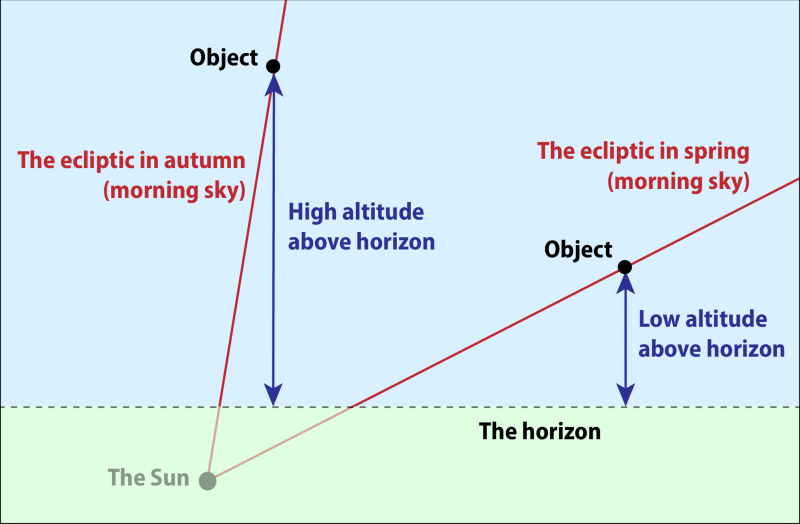The Moon will pass close to the Sun and become lost in the its glare for a few days.
The Moon's orbital motion carries it around the Earth once every four weeks, and as a result its phases cycle from new moon, through first quarter, full moon and last quarter, back to new moon once every 29.5 days.
This motion also means that the Moon travels more than 12° across the sky from one night to the next, causing it to rise and set nearly an hour later each day. More information about the Moon's phases is available here.
At new moon, the Earth, Moon and Sun all lie in a roughly straight line, with the Moon in the middle, appearing in front of the Sun's glare. In this configuration, we see almost exactly the opposite half of the Moon to that which is illuminated by the Sun, making it doubly unobservable because the side we see is unilluminated.
Observing the Moon in the days after new moon
Over coming days, the Moon will become visible in the late afternoon and dusk sky as a waxing crescent which sets soon after the Sun. By first quarter, in a week's time, it will be visible until around midnight.
Its daily progress is charted below, with all times are given in South El Monte local time.
| Date | Sun sets at |
Moon sets at |
Altitude of Moon at sunset |
Direction of Moon at sunset |
| 26 Mar 2028 | 19:07 | 18:56 | -2° | west |
| 27 Mar 2028 | 19:08 | 19:53 | 8° | west |
| 28 Mar 2028 | 19:08 | 20:51 | 19° | west |
| 29 Mar 2028 | 19:09 | 21:52 | 31° | west |
| 30 Mar 2028 | 19:10 | 22:54 | 42° | west |
| 31 Mar 2028 | 19:11 | 23:55 | 54° | west |
| 01 Apr 2028 | 19:11 | 00:53 | 65° | west |
A thin crescent
The months around the spring equinox – March and April in the northern hemisphere – present the best opportunity to see a very thin crescent Moon immediately after sunset in the days following new moon.
This comes about because the Moon appears higher in the dusk sky sooner after new moon in the spring months as compared to other times of year.
At all times, the Moon lies close to a line across the sky called the ecliptic, which is shown in yellow in the planetarium above. This line traces the path that the Sun takes through the zodiacal constellations every year, and shows the plane of the Earth's orbit around the Sun. Since all the planets circle the Sun in almost exactly the same plane, they too move across the sky following the same line.
When the Moon is widely separated from the Sun, it is separated from it along the line of the ecliptic. But, at different times of year, the ecliptic meets the horizon at different angles at sunrise. This means that a certain number of days after new moon, the Moon appears at different altitudes above the horizon at different times of year.
At sunset, the ecliptic makes its steepest angle to the horizon at the spring equinox – in March in the northern hemisphere, and in September in the southern hemisphere. Conversely, it meets the horizon at its shallowest angle at the autumn equinox. And so, very thin crescent moons are most visible in the evening sky in the spring.
The inclination of the ecliptic plane to the horizon at South El Monte varies between 79° (sunset at the spring equinox) and 32° (sunset at the autumn equinox). On March 25, the ecliptic is inclined at 79° to the western sunset horizon.
The exact moment of new moon
At the moment of closest approach, it will pass within 4°36' of the Sun, in the constellation Pisces. The celestial coordinates of the Sun and Moon will be:
| Object | Right Ascension | Declination | Constellation | Angular Size |
| The Moon | 00h13m20s | 6°28'N | Pisces | 29'41" |
| Sun (centre) | 00h20m | 2°14'N | Pisces | 32'03" |
The coordinates above are given in J2000.0.
The sky on 25 Mar 2028
| The sky on 25 March 2028 | ||||||||||||||||||||||||||||||||||
|
0% 29 days old |
All times shown in PDT.
|
|||||||||||||||||||||||||||||||||
Warning
Never attempt to point a pair of binoculars or a telescope at an object close to the Sun. Doing so may result in immediate and permanent blindness.
Source
The circumstances of this event were computed using the DE430 planetary ephemeris published by the Jet Propulsion Laboratory (JPL).
This event was automatically generated by searching the ephemeris for planetary alignments which are of interest to amateur astronomers, and the text above was generated based on an estimate of your location.
Related news
| 25 Mar 2028 | – New Moon |
| 02 Apr 2028 | – Moon at First Quarter |
| 09 Apr 2028 | – Full Moon |
| 16 Apr 2028 | – Moon at Last Quarter |
Image credit
Simulated image courtesy of Tom Ruen.



